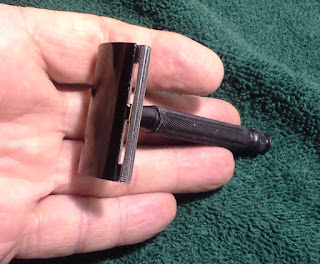Think Super Speeds are confusing? Let's talk Techs...
Introduced in 1938, the Tech is a simple three-piece razor consisting of a handle, base plate, and cap. Should be easy, right? Well...
Is the cap plain, etched, or embossed with Gillette's logo? Brass, steel, Zamak, or aluminum? Heavy handle, ball-end, fluted, or Bakelite? Standard length or short "Travel" size? Gold or nickel? Pre-war triangular drain holes or post-war oblong holes? English, US, French, Argentinian, German? Date code or no?
Many of the differences are simple to spot. The pre-war, for instance, had triangular holes in the base plate to aid in rinsing, and usually had a heavy ("fat") handle.
Civilian production was curtailed during World War II, and many variations of military models were produced. The 1945 Tech had a fluted, black-painted handle with a steel cap. Base plates could be nickel or black.
Here's the same Contract model (1946?), but in gold (next to an Old Type)...
A GI "Simplex" with Bakelite handle and base plate, steel cap, and carbon steel blades. It was issued in a snap-closure plastic case. (While not technically a Tech, it's the same three-piece design. Gillette manufactured a similar razor.)
After the war, civilian production was resumed. The Tech came with both a slim ball-end handle...
...and a Heavy handle (the "Gold Tech") like the pre-war...
Early Techs had no "Gillette" logo on the cap. An acid-etched logo appeared shortly after the war and was used to the early '60s. The oblong post-war holes can be seen here, too.
The embossed logo appeared around '63 or '64, and the material was changed from brass to Zamak (a zinc alloy). The cap also featured beveled, or "faceted" edges.
Tech production ceased in 1979. Pity, too, as this was a fabulous razor.
Note: Since these razors pretty much use similar parts, especially the interchangeability of the handles, parts can be easily swapped out to create what's known as "frankenrazors". I've seen black-handled Contracts with the gold-plated cap and base plate, and Heavy handles used on Old types. I recently bought a post-war ball-end in a clam-shell hard case, knowing they usually came in a cardboard box with a cellophane "window", but I wanted that case as well.








Very Informative and detailed article about safety razor uk
ReplyDelete